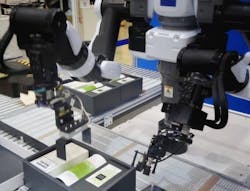6 pharma supply chain innovations that are worth the investment
The pharmaceutical supply chain begins with R&D and the drug approval process and ends with patient treatment. In-between are the organizational, operational, and value-adding steps required to manufacture and transport the medication to those in need. The drug supply chain is extremely cost and time-intensive, with inherent risks for recalls and changing regulations. To increase profitability, the health care industry must leverage advanced technology to create efficient processes and reduce costs.
In this article, we’ll look at the top six pharmaceutical supply chain innovations worth the investment:
Photo courtesy of Unsplash
Intelligent robotics
The pharma supply chain is filled with repetitive, time-consuming tasks, from filling test tubes for research to preparing medication orders for delivery. For example, medication samples must be mixed, purified, and shaken — simple tasks that require significant time. Integration of intelligent mechanics, such as robotic arms, into a manufacturer’s current equipment can complete simple tasks efficiently while communicating on progress and status with other systems, all in real-time. Robotics not only increase productivity by working consistently — 24/7 if required — but allow human staff to prioritize more complex, high-value work.
New robotic applications should be fully integrated with intelligent monitoring systems so machine data can be used to track performance in real-time and immediately alert staff to anomalies. Supportive systems and infrastructure allow manufacturers to analyze and optimize the facilities’ production, increasing value over time. To ensure the least disruption to processes, companies must roadmap a phased roll-out for integration, prioritizing areas with the most repetitive tasks, such as mixing ingredients or filling and packaging the medications.
Internet of things (IoT)
IoT and industrial internet of things (IIoT) are an ecosystem where every device, machine, and process are connected via a data communications system. This includes lab equipment employed during the drug discovery process, machines used during medication manufacturing, and enabled vehicles for treatment delivery. Connected sensors can track equipment performance markers and alert staff to maintenance needs prior to mechanical failure. This not only allows facilities to plan and schedule maintenance, minimizing downtime, but prevents expenditure for routine maintenance if not needed.
AI/ML and predictive analytics
Implementing an AI/ML strategy during drug discovery can significantly speed go-to-market time for new drugs. As the typical drug design lifecycle lasts 10-15 years and costs billions of dollars, agility and precision are crucial in drug development. Judging a potential drug candidate involves examining millions of data points, which is made possible with AI/ML capabilities. This technology can analyze vast amounts of data quickly, find hidden correlations, and generate new results — solutions that were often overlooked by traditional approaches.
Perhaps the most crucial innovation — predictive analytics — uses statistical models to gain insights from past, present, and future events. Uses of predictive technology can forecast the need for formulary changes through applying artificial intelligence (AI) and machine learning (ML) to large and multiple data sets. For example, outcomes from small changes to formulas and corresponding patient reactions can be predicted based on previously tested medications. Or analytics algorithms can form hypotheses on human drug trial participant reactions, based on similarly tested medications over hundreds of data sets.
According to McKinsey and Company, advanced analytics can improve earnings before interest, tax, depreciation and amortization (EBITA) for pharma companies by 45-75 percent over a 10-year period.
Inventory and network optimization
Not just for the warehouse, inventory and network optimization allow pharmaceutical companies to gain exceptional operational awareness into all aspects of the medication supply chain. Sensors and actuators are used within facilities that connect securely to the cloud or data center. System users can collect data to enable business intelligence (BI) and predictive analytics capabilities.
For a pharmaceutical producer, this offers insight into batch-to-batch variations and possible particulate contamination. Delicate medications, such as those requiring precise storage temperatures or short half-lives, will benefit from real-time tracking, eliminating waste and excess costs.
Smart transportation
Often labeled “intelligent mobility,” this innovation focuses on the transport of sensitive materials for the production of medications. Drugs are often most at risk of theft from the pharmaceutical manufacturer to the pharmacy or shipping destination itself. To combat these issues, companies should employ door-to-door and step-to-step tracking of the particulates, raw materials and final medications.
Transport vehicles are connected to intelligent systems that can analyze and deliver actionable and real-time insights about medication status. This allows professionals to react immediately when concerns arise. Issues can be addressed before they become costly mistakes.
Wearables and mobile tech
Laboratory technicians often work in the most hazardous conditions. Environmental factors, such as repeated exposure to chemicals and diseases, can create an adverse working environment potentially hindering the drug discovery progress. Additionally, physical factors such as stress and repetitive standing tasks may lead to employee health issues such as high blood pressure and heart attacks.
Smart workwear — wearables and mobile technology — allow employees to continue to use the usual personal protective equipment (PPE). The benefit is the internal devices placed throughout the PPE that continuously monitor environmental factors, such as hazardous chemical spills, as well as physical factors. By enabling a healthier workforce, the employer enables greater adherence to timelines and employee retention.
Getting started
While there are many technological innovations available today, the pharmaceutical industry faces unique issues that need unique answers. By implementing solutions such as robotics, analytics, IoT, and AI/ML, pharma leaders can realize true ROI and mitigate risks associated with drug discovery and production. Innovations including inventory optimization, intelligent mobility, and wearable tech, protect the people they serve and the investments made.
Throughout the transformative journey, data is the key to creating meaningful insights for growth in the pharmaceutical industry.







